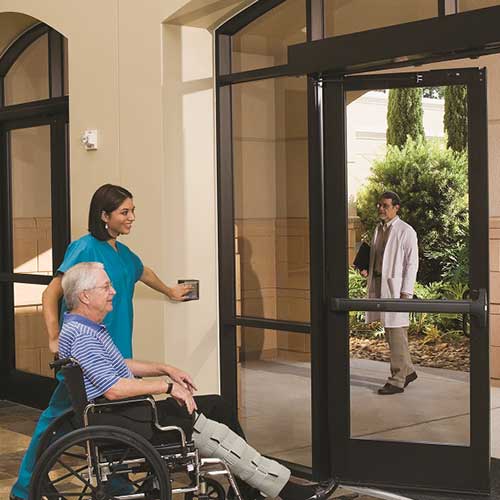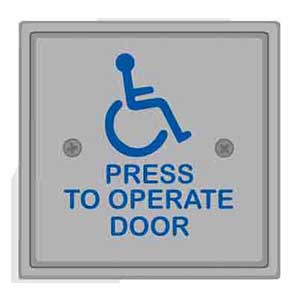Automatic door operators play a vital role in providing accessible, convenient, and secure building entrances. Whether you’re retrofitting an existing door or planning for a new installation, understanding the differences between operator types and the importance of the “Knowing Act” is essential for compliance and safety.
Types of Automatic Operators

Automatic operators generally fall into two categories:
- Low-Energy Operators
- Purpose: Ideal for mixed-use doors that some users open manually while others activate automatically.
- Standard: Governed by ANSI 156.19, which limits the speed and force of operation to ensure safety.
- Activation: Requires a Knowing Act, where users consciously trigger the door using push buttons, touchless switches, card readers, or similar devices.
- Applications: Common in schools, libraries, hospitals, and entrances designed for ADA compliance.
- Full-Energy Operators
- Purpose: Designed for high-traffic areas where doors open and close quickly.
- Standard: Governed by ANSI 156.10, which includes stricter safety measures like sensors and guard rails.
- Activation: Triggered by motion sensors that detect movement near the door.
- Applications: Grocery stores, retail outlets, and environments requiring rapid door movement.
The Knowing Act: Key to Low-Energy Operators
Low-energy operators must be activated by a “Knowing Act,” meaning the user makes a deliberate effort to trigger the door. This activation method not only complies with ADA standards but also limits potential risks by ensuring users are aware of the door’s operation.

Common Knowing Act Devices:
- Push Buttons: Available in various sizes and shapes, these can be mounted on walls, jambs, or bollards for easy accessibility.
- Touchless Switches: Hands-free solutions that enhance hygiene and convenience.
- Card Readers & Keypads: Ideal for secure facilities, providing both access control and activation.
Installation Guidelines for Knowing Act Devices
To ensure compliance with standards like ADA, ANSI 156.19, and ICC A117.1, follow these installation tips:
- Mount the actuator within 1-12 feet of the door.
- Position the device so users are not in the swing path of the door.
- Ensure a clear floor space is available for wheelchair users, beyond the arc of the door swing.
- Actuators must operate without requiring tight grasping, pinching, or twisting and should require a maximum force of 5 lbs.
Why Not Use Motion Sensors for Low-Energy Operators?
Adding motion sensors to a low-energy operator changes its classification to a full-energy opening under ANSI 156.10, which requires enhanced safety measures such as sensors and guard rails. These additions increase both the cost and complexity of the system, making Knowing Act devices a more practical solution for many applications.
Selecting the Right Operator for Your Needs
When choosing between low-energy and full-energy operators, consider the traffic flow, safety requirements, and compliance needs of your facility. For most ADA-compliant entrances, low-energy operators activated by a Knowing Act are sufficient, offering an accessible, cost-effective solution without compromising safety.
By understanding the nuances of automatic operators and their activation methods, you can ensure your building meets regulatory requirements while providing a seamless experience for users.







